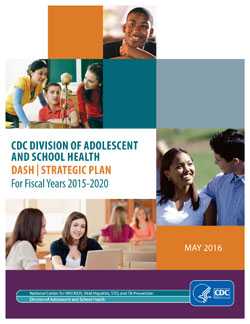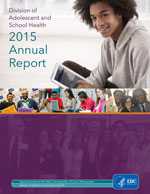About the Division of Adolescent and School Health
Overview
 CDC’s Division of Adolescent and School Health (DASH) is a unique source of support for HIV, STD, and pregnancy prevention efforts in the nation’s schools. DASH provides funding and technical assistance that enables state and local education agencies to deliver HIV and STD prevention programs that are scientifically sound and grounded in the latest research on effectiveness.
CDC’s Division of Adolescent and School Health (DASH) is a unique source of support for HIV, STD, and pregnancy prevention efforts in the nation’s schools. DASH provides funding and technical assistance that enables state and local education agencies to deliver HIV and STD prevention programs that are scientifically sound and grounded in the latest research on effectiveness.
DASH also plays a key role in working with state and local education and health agencies, national organizations, parents and teens to ensure that health and education activities support adolescent health, development, and learning. In particular, DASH focuses on ways to create safe and supportive environments so that all young people have the opportunity to learn and be healthy.
DASH is committed to its mission to promote environments where teens can gain fundamental health knowledge and skills, establish healthy behaviors for a lifetime, connect to health services, and avoid becoming pregnant or infected with HIV or STDs.
DASH Strategic Plan Through 2020
 CDC’s Division of Adolescent and School Health‘s (DASH) Strategic Plan, Healthy Teens. Successful Futures: Maximizing Opportunities for Primary Prevention of HIV and STDs—Strategic Plan Fiscal Years 2016–2020, articulates the vision, framework, and overarching goals and strategies that guide the division’s programmatic, research and surveillance efforts through 2020.
CDC’s Division of Adolescent and School Health‘s (DASH) Strategic Plan, Healthy Teens. Successful Futures: Maximizing Opportunities for Primary Prevention of HIV and STDs—Strategic Plan Fiscal Years 2016–2020, articulates the vision, framework, and overarching goals and strategies that guide the division’s programmatic, research and surveillance efforts through 2020.
Given DASH’s mission, four strategic imperatives are highlighted in the strategic plan.
- Take sexual health education to scale nationally to assure teens have access to information and skills development
- Address confidentiality protections for teens to increase their use of sexual health services
- Expand the evidence base regarding sexual and gender minority teen health to develop methods that decrease risk and increase protective factors
- Integrate substance use prevention into HIV/STD prevention efforts for teens
These strategic imperatives offer the chance to accelerate progress toward DASH’s goal of maximizing opportunities for primary prevention of HIV/STD and pregnancy among young people. As a prevention leader, DASH uses a public health approach, working through schools to increase the likelihood that the majority of teens in the U.S. will have the knowledge, skills, and resources to avoid becoming pregnant or infected with HIV or STDs.
View or download the DASH strategic plan and related materials:
CDC's Role in School Health
CDC promotes the health and well-being of children and adolescents through schools, enabling them to become healthy and productive adults. CDC supports core school health functions by:
- Funding state health and education agencies, communities, and national partners
- Using the Whole School, Whole Community, Whole Child Model
- Supporting parent engagement
- Promoting health and academic success
- Investing in surveillance and epidemiology
2015 Annual Report

The DASH 2015 Annual Report [PDF – 3M] provides a comprehensive description of the division’s activities and accomplishments during the year, features several key projects, and offers a glimpse into the future.
DASH Organization
- Leadership, Policy & Communication
- Program Development & Services
- Research Application & Evaluation
- School-Based Surveillance
Leadership, Policy & Communication
DASH’s Office of the Director provides organizational leadership for the division as well as communication and policy support. Policy activities include legislative affairs, issues management, environment monitoring, policy guidance, and the establishment and maintenance of relationships with key partner organizations. Communications activities include developing and implementing the division’s communication strategy, providing writing, editing, and graphics support for DASH products, managing DASH websites and social media platforms, providing communications guidance and technical assistance, responding to media and public inquiries, and providing critical resources and information to internal and external partners.
Program Development & Services
The Program Development and Services Branch (PDSB) works with state education agencies, local education agencies and non-governmental organizations providing capacity-building assistance to implement and support HIV, STD and pregnancy prevention efforts in schools. PDSB also helps education agencies implement strategies and approaches to reduce adolescent sexual risk behaviors and adverse health outcomes. Activities include funding and grants management, capacity building and professional development, technical assistance and guidance, and program collaboration and service integration across the National Center for HIV/AIDS, Viral Hepatitis, STD, and TB Prevention (NCHHSTP) and CDC.
Research Application & Evaluation
The Research Application and Evaluation Branch (RAEB) provides national leadership in identifying effective practices for school health programs and translates the latest scientific findings into resources for use by education agencies and non-governmental organizations. RAEB activities include developing practical tools and research-based guidance, assisting funded partners with evaluation of sexual education programs, studying risk and protective factors as well as interventions associated with adolescent sexual behavior, and determining how best to affect teens’ health care, school and community environments.
School-Based Surveillance
The School-Based Surveillance Branch (SBSB) provides the platform for school-based surveillance at CDC and studies trends in teen sexual behavior and school health policies and practices. SBSB works with state and local education and health agencies to implement the Youth Risk Behavior Surveillance System (YRBSS). SBSB also manages data collection on school health policies, programs, and practices through School Health Profiles (Profiles) and the School Health Policies and Practices Study (SHPPS) and provides technical assistance for the Global School-based Student Health Survey (GSHS).
- Page last reviewed: June 16, 2017
- Page last updated: June 16, 2017
- Content source:


 ShareCompartir
ShareCompartir